
About UsThe Numismatic Bibliomania Society is a non-profit organization promoting numismatic literature. For more information please see our web site at coinbooks.org SubscriptionsThose wishing to become new E-Sylum subscribers (or wishing to Unsubscribe) can go to the following web page link MembershipThere is a membership application available on the web site Membership Application To join, print the application and return it with your check to the address printed on the application. Membership is only $15 to addresses in the U.S., $20 for First Class mail, and $25 elsewhere. For those without web access, write to: David M. Sundman, Secretary/TreasurerNumismatic Bibliomania
Society AsylumFor Asylum mailing address changes and other membership questions, contact David at this email address: dsundman@LittletonCoin.com SubmissionsTo submit items for publication in The E-Sylum, just Reply to this message, or write to the Editor at this address: whomren@coinlibrary.com
BUY THE BOOK BEFORE THE COINYou won't regret it! |
- WAYNE'S WORDS: THE E-SYLUM DECEMBER 7, 2008
- NEW BOOK: SOCIALIST REPUBLIC OF VIET NAM COINS & CURRENCY BY HOWARD DANIEL
- MINT REPORTS FROM AROUND THE WORLD
- DAVE GINSBURG ON THE NEW ORLEANS MINT
- DAVID GINSBURG'S VISIT TO THE ANS LIBRARY
- DEALER LIVINGSTON, I PRESUME?
- REVIEW: HOLABIRD-KAGIN AMERICANA AUCTION OF BILL WEBER'S SO-CALLED DOLLARS
- MORE ON FRASER'S INDIAN HEAD NICKEL MODELS
- ELLIS EDLOW'S BOOKPLATE
- DICK JOHNSON: I NEVER MADE SHELDON'S BOOK, BUT I WAS SOMOTYPED
- MORE ON FEDERAL APD PARKING TOKENS
- MORE ON MARILYN MONROE "COINS"
- BY DUMB LUCK, COLLECTOR ACQUIRES ONE OF THE RAREST MORGAN SILVER DOLLARS
- MORE ON THE MAVERICK SCRIP NOTE OF LAFAYETTE
- JOHNSON'S ENCYCLOPEDIA
- ANOTHER "FACE" FOUND ON A COIN
- MORE ON THE 2009 BERMUDA BANKNOTES
- MORE ON ADNA WILDE
- THOMAS JEFFERSON ON BANKING INSTITUTIONS
- ALTERNATE CURRENCY PROPOSED IN MILWAUKEE NEIGHBORHOODS
- TRASH COLLECTOR FINDS £10,000 BANKNOTE JIGSAW PUZZLE
- DICK JOHNSON REFUTES COLUMNIST'S REASONS TO SAVE THE CENT
- ARTICLE: A YEAR LATER, AMAZON'S KINDLE FINDS A NICHE
- JOKE CORNER: IDI AMIN AND QUEEN ELIZABETH
- A HORSE NAMED NUMISMATIST
- FEATURED WEB SITE: SYLLOGE NUMMORUM GRAECORUM
WAYNE'S WORDS: THE E-SYLUM DECEMBER 7, 2008
 No new subscribers this week. What gives? Who can recommend us to a couple friends who'd enjoy a subscription?
No new subscribers this week. What gives? Who can recommend us to a couple friends who'd enjoy a subscription?This week has been hectic for your editor. My laptop came down with a spyware infection and had to be taken out for a cyber-colonoscopy. I think I'm pretty well caught up on my email now, but some things may have gotten dropped in the shuffle. Please contact me if you've sent a submission but don't see it here.
One thing that never ceases to amaze me about The E-Sylum is how sometimes one little one-sentence mention can blossom into some very interesting discussions a week later. This time it was Dave Ginsburg's query about U.S Mint Director reports - this week we have three related submissions.
Other topics from earlier issues continue to bear fruit as well, from James Fraser's nickel designs to parking tokens and Marilyn Monroe. To learn which regular E-Sylum contributor can been spotted in an "I was somotyped by Walter Breen" T-shirt, read on. Have a great week, everyone!
Wayne Homren
Numismatic Bibliomania Society
NEW BOOK: SOCIALIST REPUBLIC OF VIET NAM COINS & CURRENCY BY HOWARD DANIEL
Howard A. Daniel III writes:While in Viet Nam, I am arranging for my next catalog, Socialist Republic of Viet Nam Coins & Currency, to be printed here. It will be in color with card covers, but I will have some hardbound for the bibliomaniacs.
The Ho Chi Minh City Censorship Office had the CD-ROM of the catalog but it has been forwarded to Hanoi because they want the higher ups to approve it. I was expecting to come back with some copies in my suitcases and ship the rest, but it appears the printing will be delayed and I hope to come back with at least a proof copy. The shipment should arrive in Norfolk and then the Richmond Customs Office sometime in February or March 2009.
If there are any NBS members or others who would like to donate numismatic and related references of any type or variety for handing out to young and new collectors (and teachers and scout counselors too) at the two annual ANA shows, and at the Memphis International Paper Money Show, please contact me at HADANIEL3@MSN.COM. I can pick them up at the FUN Show in early January or even stop at the donors' location on the way down or back from Florida to Virginia.
MINT REPORTS FROM AROUND THE WORLD
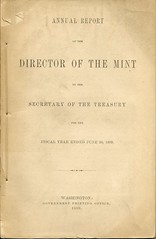 Before the 1930s the U.S. Mint Reports also contained a wealth of information on world coins and paper money. The United States had consuls posted at many places around the world -- including several in different parts of China.
Before the 1930s the U.S. Mint Reports also contained a wealth of information on world coins and paper money. The United States had consuls posted at many places around the world -- including several in different parts of China. Part of the duties of those consuls was to gather economic information, write reports, and send the information back to the USA. Some consuls were very diligent and worked hard gathering all sorts of information; others were lazy and sent back as little as they could get by with. So the information is uneven. However, some Mint Reports are gold mines of information, sometimes providing the full text of coinage reform laws and regulations or of the articles of incorporation of banks of issue.
My field of research is China. Long ago I photocopied the China sections from every U.S. Mint Report from the 1880's into the 1930's. For those interested in world coinage and paper money, another place to look is "Commerce Reports" and "Supplement to Commerce Reports". These were published weekly and monthly, if I remember correctly, from about 1915 into the 1930's, by the U.S. Commerce Department.
The information covers an incredible range of subjects -- railroads, banks, coinage, roads, radio communications, mining, manufacturing, shipping, etc. etc. for countries all over the world. The purpose of this publication was to help American manufacturers find markets in other countries or to find raw materials overseas -- especially in developing countries. It is a little known and little used source of information. I have been mining this publication at Washington University in St. Louis, but I'm sure other big libraries have a set.
And while on the subject of mint reports, mention should be made that other countries also published mint reports. Some of those mints made coins for countries other than their own. I own a few Canadian Mint reports, and I have seen British mint reports and French mint reports in one of the libraries at Harvard University. (If anyone is interested in searching the Harvard libraries -- they have about 100 libraries -- I may be able to offer some advice) What I have not seen are German mint reports. I'm sure such were published, but what is the exact title, and where, in the USA, they can be found? Does anyone know about mint reports published by other countries?
DAVE GINSBURG ON THE NEW ORLEANS MINT
For example, most people realize that the New Orleans Mint was kept busy minting Morgan dollars, not gold, but did you know that their small gold mintages were also the result of the small amount of gold that was deposited during the period? (less than one-third the amount of gold that was deposited from 1838-1860)
Did you know that the 1883 Assay Commission discovered below-standard eagles and the resulting investigation resulted in the removal of the Assayer (and perhaps the Melter & Refiner) and directions for the Mint to melt any of the coins that remained in their hands? (have to do more work to find out if any coins were melted).
Did you know that, in 1894, coins minted from some bars manufactured by the New York Assay Office were found to be of uneven fineness, resulting in the melting of 25,000 1893 half eagles (out of 110,000 minted)?
Did you know that the Mint reports include a table that shows the number of dies of each denomination that the Philadelphia mint sent to each mint? (they don't tell you obverse and reverse, but you can't have everything)
Did you know that the Mint reports include mintages for both the fiscal year and calendar year, which, because of the New Orleans Mint's small mintages, tells you if the coins were minted in the first half of the calendar year or the second half? (OK, I admit this is fairly trivial and geeky - but that's why we're numismatic researchers!)
Finally, did you know that the reason the New Orleans (and the other mints) had Treasurers before the Civil War but not after was that the position was eliminated by the Coinage Act of 1873? (The Treasurers just shifted over to focusing on being Assistant Treasurers of the United States and the mints created the position of Cashier, which wasn't an Officer position [not a Presidential appointment]).
Yes, all this (and perhaps more) will soon be detailed in the "pages" of the Southern Gold Society's eNewsletter!
For more information, see the Society's web site: The Southern Gold Society (http://www.southerngoldsociety.org/)
DAVID GINSBURG'S VISIT TO THE ANS LIBRARY
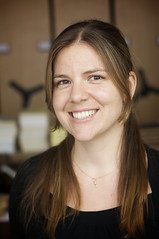 Continuing my quest for the few Mint annual reports I was missing, I, perhaps foolishly, turned down the Editor's generous offer to send me two of the reports from his library - for a modest shipping and handling fee of only $500 each - and decided to make a lunch-time trek through the wilds of Manhattan to 75 Varick Street, the new home of the American Numismatic Society.
Continuing my quest for the few Mint annual reports I was missing, I, perhaps foolishly, turned down the Editor's generous offer to send me two of the reports from his library - for a modest shipping and handling fee of only $500 each - and decided to make a lunch-time trek through the wilds of Manhattan to 75 Varick Street, the new home of the American Numismatic Society. The ANS' website recommends visitors check with the Librarian before visiting, so I called Ms. Hahn and made an appointment for noon the next day.
As at most buildings in New York, the building's front desk asked for my picture ID, signed me in and directed me to the 11th floor. Once there, I entered the unmarked main entrance and approached the bank vault-like security desk.
As I approached the security desk, I was greeted by name and, after my drivers' license was scanned to produce a picture visitor's badge, I was told that Ms. Hahn would be right out to escort me to the Library. (I quickly decided that I could get used to this sort of reception!)
As we walked down the hall, we passed the climate-controlled rare book room on the left and the Librarian's office on the right, then entered the main room, which looks surprisingly like its picture.
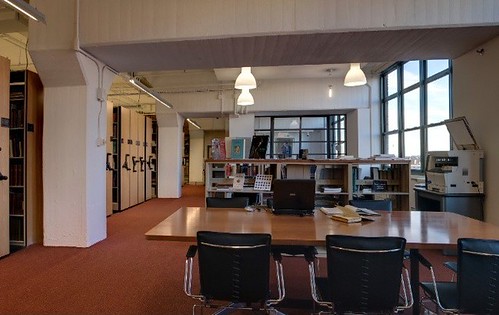
On the left you can see the rolling shelves that hold many of the Library's 100,000 items and on the right you can see one of the room's two tables and the conveniently placed photocopier. In the back of the room there's a nice conference room.
Ms. Hahn told me she's beginning to feel settled into the new space and they've kept the same subject divisions as at their former location. She said that visitors "come in spurts", but average two per week. (She also mentioned that she reads the E-Sylum when she can, but I forgot to ask if she's a subscriber or visits the website.) She then gave me a quick tour and left me to my own devices.
Well! Talk about heaven on Earth for a numismatic researcher! I briefly scanned the shelf listings and walked through a couple of rows. I recalled that I wanted a copy of an article in the September 1968 issue of Numismatic Scrapbook and quickly found it among the decades of bound volumes.
I ran my eyes over the shelves of books on economic history and briefly thumbed through a copy of the four-volume set, "Documentary History of Banking and Currency in the United States".
Somewhat regretfully, because my time was limited, I headed for the shelves marked "Mint Reports". It took me a minute to find the US Mint reports, because first I had to get past the reports from the British Mint, the Paris Mint, the Mexican Mint (and perhaps a few others) before I got to the bottom shelf where the 19th century US Mint reports were kept.
And so, after a happy half-hour of note-taking, I had the information I was missing and bid a (hopefully temporary) good-bye to the ANS Library and trekked back through the wilds of Manhattan to perch at my desk and ponder whether a government-guaranteed bond issued by a (former) investment bank should be considered a "Government security."
DEALER LIVINGSTON, I PRESUME?
John Lupia writes:
Dr. William H. Livingston, MD, 202 Julian Street, Ebensburg, Pennsylvania applied for membership in the ANA in April 1935 and joined the ANA in May 1935 as member No. 4748.
He conducted thirteen coin auctions. The final auction, held in January 1941, is not listed in Martin Genkerke's American Numismatic Auctions. Three of these were mail auction bids published in periodic magazines, two in The Numismatist and one in Numismatic Scrapbook.
He published his Bulletin which ran in three numbers, listing in each over 600 coins mostly UNC and Proofs. He ran three half page ads and one quarter page ad in Numismatic Scrapbook from September 1937 until November 1939 in addition to his one full page mail bid coin auction of 100 lots in the October issue on page 227.
He ran 35 ads in The Numismatist from November 1936 until January 1941 in addition to the two mail bid auctions which were full page. Among his ads two were full page, 24 half page, and nine quarter page ads.
In all 39 ads and three auctions were published in these two numismatic periodicals. 10 coin auction catalogs were published and mailed to those on his list or who wrote requesting one.
| FEATURED IN OUR JANUARY 10, 2009 NEW YORK PUBLIC AUCTION SALE A VERY FINE SET OF CORPUS NUMMORUM ITALICORUM INCLUDING AN ORIGINAL VOLUME 20 GEORGE FREDERICK KOLBE Email: GFK@numislit.com Tel: (909) 338-6527 | 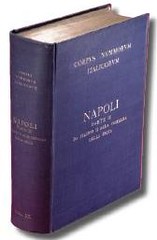 |
REVIEW: HOLABIRD-KAGIN AMERICANA AUCTION OF BILL WEBER'S SO-CALLED DOLLARS
The Holabird-Kagin Bill Weber catalogue was a quality production, the cataloguing done by so-called dollar maven Jeff Shevlin and Fred Holabird himself. The catalogue was a delight to the eyes and will assume a place in any good numismatic / exonumia library. The bulk of Bill Weber's so-called dollars had been slabbed by NGC prior to auction although the impressive full page and heart-felt catalogue foreword, dedicated to Bill Weber's life and hobby, specifically mentioned Bill's abhorrence of slabs. Still, it was a good decision by Fred Holabird inasmuch as slabbing is the "name of the game" for so-calleds and the prices realized reflected the wisdom of pre-auction slabbing.
Ron and Fred report to me that the physical attendance was approx 40 bidders plus extensive phone and website participation - an excellent showing given the specialized nature of the offering, the state of the economy, and the "remoteness" of Reno, Nevada.
Ron comments that "Prices were astounding on all better items...Six Lauer [ 1894 California ] Midwinter so-calleds totaled over $7600...PPIE [Pan Pacific 1915] North Carolina around $6,000...1876 copper [ yes, copper- only seen in silver ! ] Nevada Centennial around $7500...It was a bloodbath...Only the junker cast pieces [Calif imitation "slugs"] went cheaply and not all those did."
Fred reports additionally that a Thompson Restaurant facsimile slug, one of the most frequently seen fascimiles, sold for $862.50. The Disney HK 753 in silver brought (gasp!) $3220 - 30 silvers struck in the 1960's, the aluminum dirt-common. I can't help chuckling as I type this.
Almost across the board, the prices realized were jaw-dropping. A "take no prisoners" bidder approach. It was clearly the high slabbing grades that did it. And, to a lesser degree, the Weber pedigree and the superb catalogue presentation.
It's exonumia results like these that makes one wonder about the wisdom and hobby benefit of Heritage's dissolution of their well-received Exonumia Dept and its auction catalogues. But that's another story.
MORE ON FRASER'S INDIAN HEAD NICKEL MODELS
David Gladfelter writes:
These were large-scale models ranging in diameter from 4.75 to 6 inches. All but two of the 30 lots were illustrated in the catalog. At the ANA convention in 1981, Bowers & Ruddy Galleries auctioned eight additional models by the Frasers, none of which were provenanced to the Lepczyk sale (B&R 53:2419-2426).
Of these, three (## 2419, 2420 and 2421) were uniface relief actual-size so-called “electro-trials” of the second obverse trial design (Lepczyk #465) and one (#2422) was a uniface relief actual-size trial of the adopted reverse design. The actual-size trials were formerly listed by J. Hewitt Judd et al, United States Pattern Coins, 7th ed. (1982), appendix “A” p. 249, but were dropped from later editions because they were electrotypes, not struck from dies, see 9th ed. (2005), p.313, fn. 24.
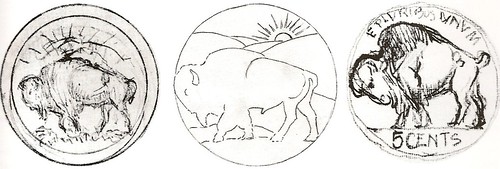
As noted in Renaissance of American Coinage 1909-1915, “…[Fraser] went a step beyond what other artists might have done. “I am having some electro-plates made of the small sketches and I will send them to you when they are completed.” He took the wax or plaster sketches to Medallic Art Company, and had Henri and Felix Weil make coin-sized reductions and electrotypes. This pushed the design from an artist’s concept – something any artist could do – to a practical metal replica that Andrew and MacVeagh could touch, admire and imagine as a real circulating coin.
By stimulating the imagination and self-image of these key treasury officials, Fraser put himself above a mere competition. Secretary MacVeagh was so completely captivated by the little metal tokens that within a few months of meeting Fraser he wrote, “…it has been decided to have you present your ideas in the form of models of the same size as the legal coin.” This was not only a complete turn-around from Andrew’s earlier comments, but indicates that MacVeagh accepted the electrotype tokens as substitutes for drawings, sketches, large models and pattern coins. More than anything else, Fraser’s bison, Indian and Lincoln tokens had succeeded in removing not only possible competing individuals, but had abolished the idea of holding any type of competition. To keep the project moving forward Fraser offered his own enthusiasm:
Free of competitors, Fraser could work unhindered with director Roberts and secretary MacVeagh on the concepts and subject.”
As Dick Johnson noted, although Fraser commonly sculpted in clay, his medallic work was transferred to plaster which was more durable for final modeling. The New Jersey article is unclear on many points, particularly the size of the mold or model. Fraser’s sketch models, from which Henri Weil made electrotypes (called “electroshells” or “electro-plates” by Fraser) were approximately 3-inches in diameter and most of the electrotypes were approximately 20mm in diameter to mimic a standard nickel.
A model suitable for reduction to coinage was generally about 5-inches diameter. Medallic Art made the first reductions and Buffalo nickel hubs in Dec 1912, They also made a second set in January from new models. After that, the final reductions were done at the Philadelphia Mint using MACO’s quality as a guide.
There are at least a dozen known plaster sketch models of the obverse of the Buffalo nickel plus several electrotype versions. Most of these were little more than studio trash to Fraser. A more extensive version of the origin of these interesting pieces begins on page 227 of Renaissance of American Coinage 1909-1915.
ELLIS EDLOW'S BOOKPLATE
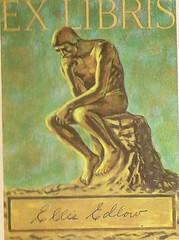 In previous issues we mentioned Ellis Edlow, the onetime legal counsel for the American Numismatic Association. I'm still curious if any of our readers have information or stories to share about Edlow and his numismatic interests.
In previous issues we mentioned Ellis Edlow, the onetime legal counsel for the American Numismatic Association. I'm still curious if any of our readers have information or stories to share about Edlow and his numismatic interests. Meanwhile, here's an image of an Ellis Edlow bookplate I found in a book recently. The book is a history of banking in the District of Columbia, where Edlow made his home. Have any of the numismatic bibliophiles out there seen this bookplate before?
DICK JOHNSON: I NEVER MADE SHELDON'S BOOK, BUT I WAS SOMOTYPED
Sheldon attempted to quantify body physiques somewhat like he quantified large cent conditions, but with a little more sophistication. He stated every human body has three characteristics. He called these ectomorph, mesomorph and endormorph. Unlike the Sheldon cent scale of 1 to 70, his numbers for these characteristics only ranged from 1 to 9.
He called his analysis a somotype; it consisted of three numbers -- the numerical ranking for each of these characteristics, separated by a hyphen. Sheldon trained Breen to do this analysis, subsequently Breen worked for Sheldon doing the somotyping of photographs and Breen became quite adapt at this.
Sheldon had tens of thousands of photographs of both sexes, from teenagers to senior citizens. All nude of course, side view and front view. Published versions obliterated genitals. Sheldon was never considered a voyeur; he was accepted as a psychologist doing scientific work. His most noted work, Atlas of Men, was published by Harper, 1954.
In 1952 Walter Breen came to Washington D.C. to do some extensive research at the National Archives. I was stationed at a nearby Air Force base and offered to assist him since we had been friends for a number of years. I drove him around Washington looking for an inexpensive room within walking distance of the Archives where he could stay for a couple months. (He found one in the basement of a house on Embassy Row next to the Ecuadorian Embassy. It had an elevator to the basement -- one of those open cage types that frightened the hell out of Walter.)
We didn't find that room on the first day however, so I invited Walter to come stay overnight in my Air Force barracks. The next day I introduced Walter to a couple of my buddies and the subject came up of Sheldon's body typing. One buddy asked Walter if he could somotype us. "Sure," he said. "Take off all your clothes."
So we stripped in the hallway. Having naked men in the hallway was not unusual in a men's barracks as the showers were at the end of the hall, and we often ran from showers to our rooms with only clogs on. We posed for Walter, front and side views. He was very professional, a dozen feet away.
Walter assigned a 3-3-3 somotype to me. This is the most perfect somotype possible. I don't know whether he was being nice to me with such a perfect score, or I was, indeed, in top military physique at the time.
The differences in the three characteristics can be expressed best, as I remember, in the extremes -- the ectomorph is more brain than brawn of slender build; the endomorph is the fat man, the mesomorph is the muscular jock. A very skinny man would be a 1 ectomorph, the very obese a 9 in endormorphy, for example. The number scheme was skewed on the high side.
Sheldon carried his analysis to an extreme. He claimed he could tell of other human traits from a person's somotype. Obviously a 9 in endormorphy is going to be sedimentary, a 9 in mesomorphy will always be working out, and such.
In contrast to the numismatic field's embracing Sheldon's grading scale over the years, today the medical field looks on Sheldon's somotyping of body physiques only as a curiosity. (However bodybuilding and forensics still use the technique for body analysis.)
I once sent my copy of Penny Whimsy to Dr. Sheldon, mentioning I was a friend of Walter and requesting he autograph it please. He retuned it unsigned with a curt note stating have Walter sign it. The only author I experienced who refused to sign his own book.
If you want to look at drawings of nude men and women typical of the three somotypes, click on: Somotype (http://www.exrx.net/FatLoss/Somotype.html)
For an article on Sheldon as a troubled man see: A Closer Look at William H. Sheldon (http://www.innerexplorations.com/psytext/acloser.htm)
MORE ON FEDERAL APD PARKING TOKENS
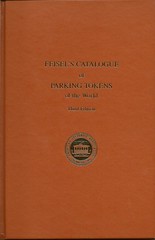 Larry Dziubek writes:
Larry Dziubek writes: PARKING TOKENS MANUFACTURERS STOCK
PTMS-3090 A 25mm Bronze 25¢
PTMS-3090 B 25mm Brass 25¢
PTMS 3090 C 22mm Brass 50¢
Author Duane H. Feisel writes:
These tokens are what are called “stock tokens” issued for use in parking gates equipped to collect tokens, usually to gain entrance to a parking lot but sometimes used for exit. These stock tokens were sold in quantity to businesses having gate-controlled parking lots who did not want to go to the expense of having custom made tokens manufactured.
These parking tokens and many, many others are catalogued in Feisel’s Catalogue of Parking Tokens of the World. The sixth edition of this catalog is available at a cost of $65 from Joseph V. Pernicano, 58 Sonia Lane, Broomall, PA 19008. After moving to California I passed along the job of cataloging parking tokens to Joe, while I have moved on to other token-related projects including writing catalogs of California saloon tokens, California encased coins, California US Bicentennial issues, and California Food Stamp Change Tokens.
A current project is the preparation of a catalog of unattributed maverick saloon tokens and a comprehensive index of United States saloon tokens to be published as an addendum to Saloon Tokens of the United States by Al Erickson, and available from him at a cost of $65 postpaid – Al Erickson, PO Box 99667, Lakewood, WA 98496.
An earlier article noted that Federal APD moved at one point to Novi, Michigan. Tom DeLorey writes:
THE BOOK BAZARRE
MORE ON MARILYN MONROE "COINS"
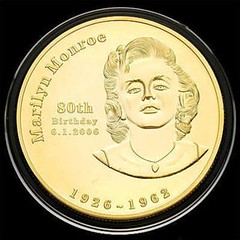 Last week, an article about a student numismatic display in India mentioned "a rare coin of the US with an image of Marilyn Monroe issued in 1962". Curious, I asked if anyone knew what "coin" this might be. Pete Smith forwared an image of a 2006 piece commemorating the actress' birthday. He writes:
Last week, an article about a student numismatic display in India mentioned "a rare coin of the US with an image of Marilyn Monroe issued in 1962". Curious, I asked if anyone knew what "coin" this might be. Pete Smith forwared an image of a 2006 piece commemorating the actress' birthday. He writes: BY DUMB LUCK, COLLECTOR ACQUIRES ONE OF THE RAREST MORGAN SILVER DOLLARS
Inspired by my earlier query about numismatically significant circulation finds, Peter Gaspar writes:Around 1953, when I was a teenager, a friend and I went to the Bank of California branch on Wilshire Blvd. in Beverly Hills, and we asked the teller for ten silver dollars. We bicycled back to his house to divide the coins, deciding to take turns - he won first pick on the toss of a penny.
Neither he nor I knew our Morgan dollars well, as will be painfully obvious in a moment, and the last round came down to a shiny Peace dollar and a toned Morgan that had circulated enough for the coin to be reduced to what we would now call VF. It was the most heavily circulated silver dollar I have ever seen. My friend picked the Peace dollar, leaving me with the runt of the litter. Only that runt was an 1893-S that I still cherish. Sometimes luck saves the ignorant.
MORE ON THE MAVERICK SCRIP NOTE OF LAFAYETTE
Last week I published an image of a maverick piece of scrip provided by Dennis Schafluetzel. He wrote:
Bruce Smith writes:
Anne Bentley of the Massachusetts historical Society writes:
- a SW county of AR, capital New Lewisville
- a county of FL, capital Mayo
- a parish in S. part of LA, capital Lafayette a banking post-town
- a county in the N. part of MS, capital Oxford
- a county in the W. part of MO, capital Lexington
- a county in the SW part of WI, capital Darlington
- a post-village of Contra Costo Co., CA
- a post-town of Boulder Co., CO
- a banking post-town of Walker Co., GA
- a banking post-village of Stark Co., IL
- a city, capital of Tippecanoe Co., IN
- a post-hamlet of Linn Co., IA
- a banking post-town of Christian Co., KY
- a post-township of Gratiot Co., MI
- a banking post-village of Nicollet Co., MN
- a post-village of Sussex C0., NJ
- a post-village of Onondaga Co., NY
- a post-village of Allen Co., OH
- a post-village of Madison Co., OH
- a post-town of Yamhill Co., OR
- a township of McKean Co., PA
- a post-village of Washington Co., RI
- a banking post-village of Macon Co., TN
- a post-village of Upshur Co., TX
- a post-village of Montgomery Co., VA
- a post-township of Chippewa Co., WI
- a town of Monroe Co., WI
- a town of Walworth Co., WI
Happy hunting!
Walt Wiegand writes:
1860: Reuben Frank, age 28, b: Germany; unmarried and living with an older relative in Lafayette, Tippecanoe County, Indiana; "deals in hides"
1870: R.H. Frank, age 38, b: Prussia; "[undecipherable word] Merch't"; living with wife, Julia, and young son in the 3rd Ward, Vicksburg, Warren Cty, Mississippi
1880: Reuben Frank, age 48, b: Prussia; "Bar Keeper"; living with wife and large family in the 2nd Ward, Vicksburg, Warren Cty, Mississippi
From the Family Search website: Reuben H Frank married Julia Leyens, 9 September, 1868 in Warren Cty, Mississippi
Sounds like your guy, but couldn't find any mention of "Frank's" in the SPMC Indiana book. Hope this is useful.
JOHNSON'S ENCYCLOPEDIA
To ascertain "agio" was a legitimate English word I check with my Webster's Unabridged Third Edition. Sure enough it is defined there. So I added it to my Encyclopedia of Coin and Medal Technology manuscript. This term brought the total number terms to 1,833. This manuscript covers the entire spectrum of the technical end of die struck coins and medals -- how they are made, used, collected and curated. I don't have a lot of collectors' terms (I am still undecided yet to include slab or slabbed) but you will find 101 terms with the word "die" in it, for example, or 27 terms with the word mint it them. There are four kinds of relief used for coins and medals, and I define the nine types of proof finish.
As with such projects I am 99% complete. I have only 12 more terms to compile, the most difficult, of course, to write up. At this stage I must use an editor (even though I have been one in the past). I am looking for someone who may not be a numismatic technologist, but rather someone who is so savvy in the field he could detect an error even if he was unfamiliar with the specific technology.
I have found that editor, and his name will not surprise you. As an E-Sylum reader, you, of course, will know Wayne Homren. I am impressed with Wayne's widespread knowledge of numismatics and his work ethic. The 1,833 terms logically divide into 14 categories and I have sent Wayne the first four categories listed in this manuscript.
Wayne is one of the busiest persons I know, but I am certain he will edit this manuscript in due time. Give a big job to a busy person and he will get it done!
Thanks again, Nancy! Keep on encouraging people to read in the numismatic field. Even in your retirement. You will never know, you just may have inspired someone to write another numismatic book!
ANOTHER "FACE" FOUND ON A COIN
Philip Mernick of London writes:The coin has a face they say, and yes, you can see what looks like a Pokemon figure, unfortunately it is a denier viewed upside down! What it actually shows is a building. Richard Lobel has had many years of coin trade experience so I trust this "mistaka" was made by a staffer. I was later advised by an expert on medieval French coinage that the coin is not even from France but is a Frankish issue from Greece!

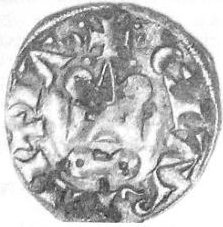
MORE ON THE 2009 BERMUDA BANKNOTES
Joe Boling writes:1. Watermark and hibiscus flower visible when held to light (an orchid in the HK note)
2. See-through feature when held to light (also in the HK note)
3. Serial numbers increasing in size (not used for the HK note)
4. Iridescent band on the $20, $50 and $100 denominations (present in the HK note, with a face value of only US$1.30)
5. Latent image (tilt the image and the denomination numeral appears) (present in the HK note, but not part of the intaglio printing, which it where latent images usually appear)
6. Ultraviolet denomination block center face
7. Ultraviolet-reactive red and blue-green threads embedded in the paper (invisible in white light)
8. Windowed security thread
9. Mechanical embossing in three areas of the note
About the only current features not present on the HK note are the Eurion Constellation, an optically-variable device ("hologram"), and lettering in the windowed thread. The HK note was reissued in 2007 on a polymer substrate - all of the above features are still present except for the threads (UV and windowed). An added feature is a transparent window in the polymer, taking the place of part of the watermark (but two areas of watermark are still present, even in the polymer). For a note of such low face value, it's a model of technology.
MORE ON ADNA WILDE
Joe Boling writes:He was not aware that he had been shot, and continued to move his platoon forward toward their objective. It was only after reaching and securing the objective that he had occasion to reach inside his shirt and the hand came out bloody - at that point he realized he had been wounded. He was evacuated for treatment. His silver star was awarded for continuing to press forward while wounded. I had the impression that, since he did not know he had been wounded, he felt the award was a bit inappropriate.
THE BOOK BAZARRE
THOMAS JEFFERSON ON BANKING INSTITUTIONS
Thomas Jefferson, 1802:
ALTERNATE CURRENCY PROPOSED IN MILWAUKEE NEIGHBORHOODS
Residents from the Milwaukee neighborhoods of Riverwest and East Side are scheduled to meet Wednesday to discuss printing their own money. The idea is that the local cash could be used at neighborhood stores and businesses, thus encouraging local spending. The result, supporters hope, would be a bustling local economy, even as the rest of the nation deals with a recession.
"You have all these people who have local currency, and they're going to spend it at local stores," said Sura Faraj, a community organizer who is helping spearhead the plan. "They can't spend it at the Wal-Mart or the Home Depot, but they can spend it at their local hardware store or their local grocery store."
Incentives could be used to entice consumers into using the new money. For example, perhaps they could trade $100 U.S. for $110 local, essentially netting them a 10 percent discount at participating stores. It's not a new concept—experts estimate there are at least 2,000 local currencies all over the world—but it is a practice that tends to burgeon during economic downturns. During the Great Depression, scores of communities relied on their own currencies.
And it's completely legal.
As long as communities don't create coins, or print bills that resemble federal dollars, organizations are free to produce their own greenbacks—and they'd don't even have to be green.
To read the complete article, see: Milwaukee neighborhoods could print own money (http://www.chicagotribune.com/business/chi-talk_moneydec03,0,2902061.story)
TRASH COLLECTOR FINDS £10,000 BANKNOTE JIGSAW PUZZLE
Graham Hill found the large bundle of cut up 10- and 20-pound notes while emptying bins in Lincoln last May, according to the Lincolnshire Echo newspaper.
He handed the package to police, but after six months no one had claimed the notes and investigators could find no evidence that it was stolen or linked to criminal activity.
The Bank of England said it would exchange the notes for new ones if Hill could piece the money back together again.
Colleagues of Hill's are hoping he gets to work quickly.
"I just hope he pieces enough of the notes back together to get a round of drinks in at the works Christmas do," a co-worker was quoted as saying. "Christmas is only around the corner, so any bonus will be welcome."
To read the complete article, see: Refuse man collects £10,000 banknote jigsaw (http://uk.reuters.com/article/domesticNews/idUKTRE4B31J320081204)
DICK JOHNSON REFUTES COLUMNIST'S REASONS TO SAVE THE CENT
(1) Merchants will always round up costing citizens $100 millions a year. Not true. A recent study mentioned here in E-Sylum previously that. at the most, it would balance out, costing an average family no more than $2 a year (saving hundreds of millions at the mint, in banking, and in retail stores). Also, as evidenced by a drug chain in Israel when the lowest coin was eliminated, they always rounded down, advertised this widely and gained a competitive advantage over their competitors.
(2) Charities would lose out from penny drives. Wrong again. Wouldn't they now have nickel drives? How much more would that net the charities! Why does the figure five come to mind?
(3) He remembered a custom from his youth when neighbors at Halloween stuck a dozen or more cents in a apple and handed these to children. You couldn't eat the apple and you had to wash the coins before you could spend them. No wonder this custom faded, not good use of either apples or cents.
Sorry, Peter your reasons are specious. Why not eliminate the lowest denomination coin in America like other counties have already, and Canada is strongly considering. Such a program would save money at every step of retail trade, not to mention the handling costs for banks, and the unwieldy cost in producing the coins at the Mint. The cent must ultimately be abolished - it is no longer viable as a circulating coin denomination.
Hundreds of billions in savings far outweigh any specious sententimentality for the old cent.
To read the complete article, see: Peter Funt: Don't dump the penny (http://www.montereyherald.com/opinion/ci_11145541?nclick_check=1)
Dick adds:
ARTICLE: A YEAR LATER, AMAZON'S KINDLE FINDS A NICHE
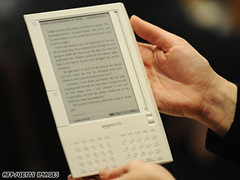 Amazon.com's electronic Kindle reader -- a device meant to remove the paper from the page and make reading both more convenient and eco-friendly -- is celebrating its first birthday.
Amazon.com's electronic Kindle reader -- a device meant to remove the paper from the page and make reading both more convenient and eco-friendly -- is celebrating its first birthday.Released in November 2007, the Kindle has sold more than a quarter million units. Its texts account for 10 percent of Amazon's book sales despite the fact that 200,000 titles -- a tiny fraction of the books offered on the site -- are available in digital form.
While exact sales figures are hard to come by, recent estimates have put the Kindle's sales on par with other high-profile mobile devices in their first year. Amazon.com says that the Kindle is currently sold out due to heavy demand.
So what has spurred its success? After all, electronic books have been around, in small numbers, for about a decade. Even Jeff Bezos, Amazon's founder and CEO, has admitted that the book is "elegantly suited to its purpose. It's hard to improve on."
One thing that's helped the Kindle is marketing. Where other readers failed to connect with consumers, the Kindle has excelled. The media-savvy Bezos has hardly been publicity shy, gaining his electronic toy a level of exposure most CEOs couldn't begin to fathom.
"You can't discount the prominence of having Amazon behind this," says Paul Reynolds, technology editor at Consumer Reports. "Jeff Bezos is respected for what he's done with Amazon, and if he feels this is a future product in media, people are willing to trust him."
Second, the gadget has been heralded by Oprah Winfrey, whose influence in the publishing world is immense. It's also been embraced by some prominent writers, including Nobel laureate Toni Morrison and best-selling thriller author James Patterson.
Third, with more and more consumers accustomed to reading text on their cell phones and BlackBerrys, the world finally may be ready for an electronic version of a book.
"I checked it out on Amazon and thought it was an intriguing idea, a great way to have a lot of books that don't take up a lot of space," says Emily Branch of Florida, who was moved to buy a Kindle after seeing the hosts of "The View" chatting about it.
"I figured if I didn't like it I could return it within 30 days," Branch says. "There wasn't a chance of that happening once I got it in my hands though."
One clutter-killing Kindle can hold about 200 books. And while other e-readers such as Sony's Reader must connect through a USB port to upload content, the Kindle is a wireless device, thanks to Whispernet, which is powered by Sprint's high-speed data network.
"I think the Whispernet is what sets the Kindle apart from all the other e-readers on the market," says Leslie Nicoll of Portland, Maine, who co-authored "The Amazon Kindle F.A.Q." book after her tech-loving teenage daughter urged her to get a Kindle.
To read the complete article, see: A year later, Amazon's Kindle finds a niche (http://www.cnn.com/2008/TECH/12/03/kindle.electronic.reader/index.html)
JOKE CORNER: IDI AMIN AND QUEEN ELIZABETH
Like Aunt Jemima pancakes, the negative racial stereotypes were deemed offensive to modern Brit blacks of African ethnic backgrounds and were dropped in the 1970s. The co-incidence in timing was the subject matter of this joke, originally formulated before our current climate of political correctness became so pervasive, and we hope that its repetition is viewed in the context of its time and for that reason does not offend any of our worldly and sophisticated readers.
As it was told, Ugandan President Idi Amin telephoned Queen Elizabeth to gently break t6he news that Uganda was declaring independence. He said: "I hope you don’t mind, Ma’am, but we’ve taken your picture off our stamps." To which Liz was alleged to have replied: "That’s OK. We took your picture off the marmalade."
A HORSE NAMED NUMISMATIST
To read the complete article, see: Golden Yank Targets Zia Park Derby (http://racing.bloodhorse.com/article/48258.htm)
FEATURED WEB SITE: SYLLOGE NUMMORUM GRAECORUM
This week's Featured Web Site was suggested by Larry Mitchell.The project was inaugurated in 1931 with the publication of the collection of Capt. E.G. Spencer-Churchill. A new and distinctive format was used, with text and illustrations on facing pages. This meant that only limited text was included, with the illustrations having greater prominence than in earlier types of catalogues, and to some extent replacing textual descriptions. This is because the primary purpose of SNG was to make much more material available for study. This format has been retained ever since and has been adopted, along with the title Sylloge Nummorum Graecorum, for similar projects in many other countries, including Denmark, France, Germany, Greece, Israel, Sweden, Switzerland and the United States.
www.sylloge-nummorum-graecorum.org

